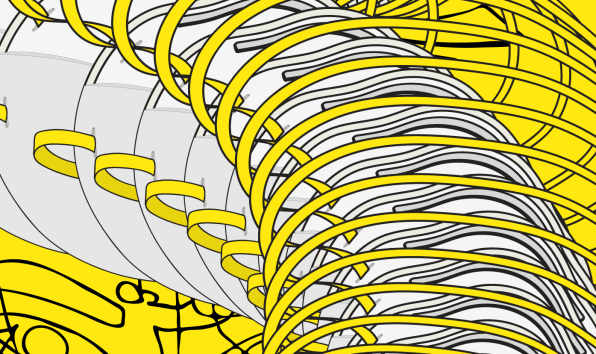
Before the COVID-19 pandemic, I was part of a research team investigating the design of health equipment, including masks. Masks are important for protecting healthcare workers. The Centers for Disease Control and Prevention may even suggest that the general population start wearing them in public (contradicting previous advice). But masks aren’t foolproof. That’s because many of them are poorly designed.
HOW MASKS WORK
A basic understanding of how masks work helps. Masks are filters. The material used in a standard surgical mask (by far the more common type of mask) reduces transmission of bacteria. Both bacteria and viruses are microscopic microbes, but they differ greatly. Bacteria are living cells, while a virus is a particle that requires a host cell to replicate. A coronavirus virion (particle) is spherical, averaging around 125 nanometers in diameter. Compare that to bacteria’s 1,000-nm size. It’s a grape compared to a grapefruit. A surgical mask whose purpose is to block bacteria will do little to prevent passage of the smaller coronavirus particle. That’s why N95 masks, which block 95% of all airborne particles, are the gold standard in hospitals treating COVID-19 patients. They have a much more selective filter.
SHORTCOMINGS IN THE CURRENT DESIGNS
But even N95 masks are flawed. Before coronavirus, my team and I investigated whether N95 masks could be a viable alternative to standard surgical masks. Interviews with doctors and nurses at several hospitals at the time revealed that N95 masks were rarely used or supplied. The overwhelming majority of healthcare workers I spoke with had never worn one. They are more expensive than surgical masks, they’re harder to breathe in, and medical workers deemed them unnecessary for most procedures. (Keep in mind that masks protect in both directions. They protect the wearer from airborne particles or splash, and protect the patient from contamination by the surgical staff—the latter is especially important in procedures that require deep incisions.)

Problematically, masks seem like they weren’t designed for people’s actual faces. Although some masks require two ties around the back of the head, doctors we observed often just tied one—it’s easier to breathe when one is left loose. (The nurses were generally better behaved.) What’s more, tying the straps around your head might cause the mask to pucker at the cheeks, creating gaps; and gaps above the cheekbones result in an upward flow of breath that fogs glasses. Even just talking can make the mask creep down from the nose. Yawning does the same but more quickly. Biomechanically, face movement and mask movement don’t align—the jaw’s pivot point is near the ear, while the mask flexes near the mouth.Compare an eighth-inch gap at the cheek with a bacteria cell or virus particle that can only be detected using an electron microscope, and you can understand why many are skeptical that masks can protect the masses, let alone healthcare workers.
RETHINKING THE N95 MASK
Masks certainly aren’t useless. They should be worn. Even wearing a surgical mask while out shopping, although it won’t block coronavirus virus particles, can remind you not to touch your face—or prevent you from doing what I mindlessly did at the supermarket a week ago, lick my fingers when I had trouble opening one of those thin plastic vegetable bags that I tore off the roll.

In analyzing mask design, it wasn’t difficult to imagine a better, more ergonomic N95 mask. Our team came up with solutions that used design elements no more complicated than those incorporated into a typical baby diaper. Here are some of the ways both surgical and N95 masks could be improved.
- The mask has to be adjustable. Sealing a mask around the nose and cheeks, following compound contours, requires significant adjustment. Narrow noses present concave shapes, broad noses convex. People often put masks on quickly, without taking time to follow those contours to seal areas that are critical for protection.
- Air leaks near the eyes need to be sealed. Otherwise, they cause eyewear to fog (which can make wearers touch their face when they attempt to defog their glasses).
- The act of tying the mask around the head offers a sense of security, as opposed to stretching an elastic strap around the head or ears.
- Stretchable materials are a must. A non-flexible mask constricts jaw movement, which makes it hard to talk and can make the wearer feel claustrophobia. Stretchable materials also seal to the face, even when a person yawns. Current masks don’t do this.
- Visual obstruction needs to be minimized. The lower portion of the visual field is important, for healthcare workers especially, yet it can be obscured by a mask’s nose and chamber design.
- Comfort is key. Healthcare workers have enough to worry about without being bothered by uncomfortable masks that need to be worn for hours at a time, or touched to be repositioned.
- Aesthetics matter. None of the healthcare workers we spoke with said aesthetics were a priority, but they did describe the “duck bill” design of some masks as “ridiculous.” There’s clearly room for improvement.

Right now, better training for healthcare workers, increased awareness of risks, and more care when applying and adjusting masks will immediately improve the protection afforded by both surgical and N95 masks. But we really need better design. Masks simply aren’t face-compliant. Like many disposable hospital products, masks are commodity items. Selection is based on cost. Design is not a focus. Fit, comfort, and performance are sacrificed. And innovation is lacking.
Maybe, by necessity, that will change shortly.
